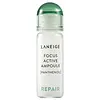What's inside
What's inside
 Key Ingredients
Key Ingredients

 Benefits
Benefits

 Concerns
Concerns

No concerns
 Ingredients Side-by-side
Ingredients Side-by-side

Water
Skin ConditioningButylene Glycol
HumectantSnail Secretion Filtrate
Skin ConditioningGlycerin
HumectantCetyl Ethylhexanoate
EmollientNiacinamide
SmoothingSodium Hyaluronate
HumectantCetearyl Olivate
Sorbitan Olivate
EmulsifyingSimmondsia Chinensis Seed Oil
EmollientArgania Spinosa Kernel Oil
EmollientHelianthus Annuus Seed Oil
EmollientCarthamus Tinctorius Seed Oil
MaskingUrea
BufferingGlyceryl Stearate
EmollientPalmitic Acid
Emollient1,2-Hexanediol
Skin ConditioningPentylene Glycol
Skin ConditioningZanthoxylum Piperitum Fruit Extract
Skin ConditioningPulsatilla Koreana Extract
Skin ConditioningUsnea Barbata Extract
Sh-Oligopeptide-1
Skin ConditioningBee Venom
AstringentCetearyl Alcohol
EmollientXanthan Gum
EmulsifyingStearic Acid
CleansingTocopheryl Acetate
AntioxidantAlthaea Rosea Root Extract
HumectantAloe Barbadensis Leaf Extract
EmollientPanthenol
Skin ConditioningLauric Acid
CleansingMyristic Acid
CleansingAloe Barbadensis Leaf Juice
Skin ConditioningBeta-Glucan
Skin ConditioningPlantago Asiatica Extract
Skin ConditioningDiospyros Kaki Leaf Extract
Skin ProtectingSalix Alba Bark Extract
AstringentUlmus Campestris Bark Extract
AstringentLaminaria Digitata Extract
Skin ProtectingAdenosine
Skin ConditioningPolysorbate 20
EmulsifyingLecithin
EmollientWater, Butylene Glycol, Snail Secretion Filtrate, Glycerin, Cetyl Ethylhexanoate, Niacinamide, Sodium Hyaluronate, Cetearyl Olivate, Sorbitan Olivate, Simmondsia Chinensis Seed Oil, Argania Spinosa Kernel Oil, Helianthus Annuus Seed Oil, Carthamus Tinctorius Seed Oil, Urea, Glyceryl Stearate, Palmitic Acid, 1,2-Hexanediol, Pentylene Glycol, Zanthoxylum Piperitum Fruit Extract, Pulsatilla Koreana Extract, Usnea Barbata Extract, Sh-Oligopeptide-1, Bee Venom, Cetearyl Alcohol, Xanthan Gum, Stearic Acid, Tocopheryl Acetate, Althaea Rosea Root Extract, Aloe Barbadensis Leaf Extract, Panthenol, Lauric Acid, Myristic Acid, Aloe Barbadensis Leaf Juice, Beta-Glucan, Plantago Asiatica Extract, Diospyros Kaki Leaf Extract, Salix Alba Bark Extract, Ulmus Campestris Bark Extract, Laminaria Digitata Extract, Adenosine, Polysorbate 20, Lecithin
Water
Skin ConditioningPropanediol
SolventGlycerin
HumectantCoco-Caprylate/Caprate
EmollientPanthenol
Skin ConditioningPolyglyceryl-3 Distearate
Emulsifying1,2-Hexanediol
Skin ConditioningBetaine
HumectantXanthan Gum
EmulsifyingGlyceryl Caprylate
EmollientGlyceryl Stearate Citrate
EmollientEthylhexylglycerin
Skin ConditioningButylene Glycol
HumectantAcrylates/C10-30 Alkyl Acrylate Crosspolymer
Emulsion StabilisingMentha Arvensis Leaf Extract
MaskingBeta-Glucan
Skin ConditioningAureobasidium Pullulans Ferment
Skin ConditioningTocopherol
AntioxidantWater, Propanediol, Glycerin, Coco-Caprylate/Caprate, Panthenol, Polyglyceryl-3 Distearate, 1,2-Hexanediol, Betaine, Xanthan Gum, Glyceryl Caprylate, Glyceryl Stearate Citrate, Ethylhexylglycerin, Butylene Glycol, Acrylates/C10-30 Alkyl Acrylate Crosspolymer, Mentha Arvensis Leaf Extract, Beta-Glucan, Aureobasidium Pullulans Ferment, Tocopherol
Alternatives
Ingredients Explained
These ingredients are found in both products.
Ingredients higher up in an ingredient list are typically present in a larger amount.
1,2-Hexanediol is a synthetic liquid and another multi-functional powerhouse.
It is a:
- Humectant, drawing moisture into the skin
- Emollient, helping to soften skin
- Solvent, dispersing and stabilizing formulas
- Preservative booster, enhancing the antimicrobial activity of other preservatives
Beta-Glucan is a polysaccharide. It can be derived from the cell walls of seaweed, oats, yeast, and fungi. It hydrates the skin and helps boost your skin's natural barrier.
As an antioxidant, beta-glucan helps fight free-radicals. Free-radicals are molecules that may damage your skin cells, such as pollution.
Studies show this ingredient may be an effective wrinkle reducer as it can deeply penetrate into skin. It has also been show to help with wound healing.
Learn more about Beta-GlucanButylene Glycol (or BG) is used within cosmetic products for a few different reasons:
Overall, Butylene Glycol is a safe and well-rounded ingredient that works well with other ingredients.
Though this ingredient works well with most skin types, some people with sensitive skin may experience a reaction such as allergic rashes, closed comedones, or itchiness.
Learn more about Butylene GlycolGlycerin is already naturally found in your skin. It helps moisturize and protect your skin.
A study from 2016 found glycerin to be more effective as a humectant than AHAs and hyaluronic acid.
As a humectant, it helps the skin stay hydrated by pulling moisture to your skin. The low molecular weight of glycerin allows it to pull moisture into the deeper layers of your skin.
Hydrated skin improves your skin barrier; Your skin barrier helps protect against irritants and bacteria.
Glycerin has also been found to have antimicrobial and antiviral properties. Due to these properties, glycerin is often used in wound and burn treatments.
In cosmetics, glycerin is usually derived from plants such as soybean or palm. However, it can also be sourced from animals, such as tallow or animal fat.
This ingredient is organic, colorless, odorless, and non-toxic.
Glycerin is the name for this ingredient in American English. British English uses Glycerol/Glycerine.
Learn more about GlycerinPanthenol is a common ingredient that helps hydrate and soothe the skin. It is found naturally in our skin and hair.
There are two forms of panthenol: D and L.
D-panthenol is also known as dexpanthenol. Most cosmetics use dexpanthenol or a mixture of D and L-panthenol.
Panthenol is famous due to its ability to go deeper into the skin's layers. Using this ingredient has numerous pros (and no cons):
Like hyaluronic acid, panthenol is a humectant. Humectants are able to bind and hold large amounts of water to keep skin hydrated.
This ingredient works well for wound healing. It works by increasing tissue in the wound and helps close open wounds.
Once oxidized, panthenol converts to pantothenic acid. Panthothenic acid is found in all living cells.
This ingredient is also referred to as pro-vitamin B5.
Learn more about PanthenolWater. It's the most common cosmetic ingredient of all. You'll usually see it at the top of ingredient lists, meaning that it makes up the largest part of the product.
So why is it so popular? Water most often acts as a solvent - this means that it helps dissolve other ingredients into the formulation.
You'll also recognize water as that liquid we all need to stay alive. If you see this, drink a glass of water. Stay hydrated!
Learn more about WaterXanthan gum is used as a stabilizer and thickener within cosmetic products. It helps give products a sticky, thick feeling - preventing them from being too runny.
On the technical side of things, xanthan gum is a polysaccharide - a combination consisting of multiple sugar molecules bonded together.
Xanthan gum is a pretty common and great ingredient. It is a natural, non-toxic, non-irritating ingredient that is also commonly used in food products.
Learn more about Xanthan Gum